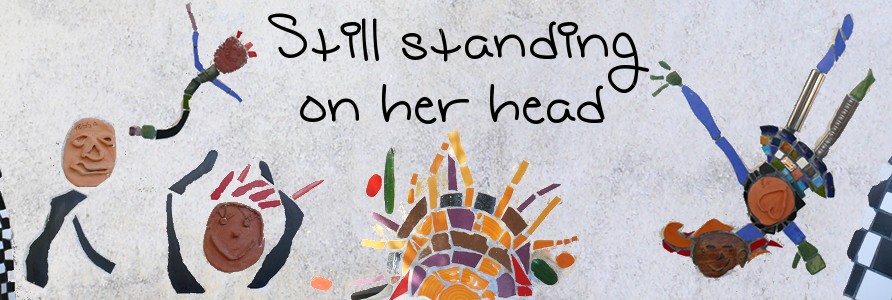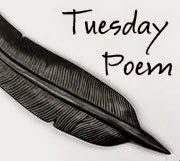"Unleash the Poem Within" by Wendy Nyemaster published by Source Books.
I received a review copy of this book a while ago, just about the time that Juliet posted her review on her blog Crafty Green Poet and then again on readwritepoem.
I enjoyed reading the book, but found myself wondering what I could say about it that Juliet hadn't said already. It is, as Juliet has said, aimed at beginning poets. As a cross between a writing book and a self-help book, I would say that it definitely leans towards the self-help end of the spectrum. (It is listed on the publisher's website under "health and wellness" rather than under "poetry").
I found that my thoughts clarified a little after I picked up a copy of Sheila Bender's book "Writing Personal Poetry" in our public library, and compared the two books, which are both aimed at beginners. Bender's book however, is definitely more focussed on writing than on self-help.
Wendy believes in writing poetry in form, and presents a number of different forms, one in each chapter. She believes that the restraints of form mean that the poet has to work harder to find the right word. This may be so (and I find it absorbing to try to write in traditional forms, myself), but she doesn't really address the factors that determine the "right word". The danger in writing rhyming metrical verse can be that a word which may be wrong in other ways is chosen merely to fit the rhyme and meter, and Wendy doesn't address this problem.
It can be true, of course, that beginning poets don't always understand that so-called "free verse" may also have restraints, and they may not work so hard to find the right word or musical turn of phrase, thinking that "prose with line breaks" is free verse. Sheila Bender firmly favours free verse, but she makes it clear that it is something more than prose with line breaks, and that it has rhythm and phrasing of its own.
The forms that Wendy presents start with the sonnet, the sestina and the ghazal, but she also includes a number of "forms" which are actually types of poems, such as odes, letter poems and "epiphanies". So in fact although she encourages rhyme and meter, these chapters also encompass freer poetic forms. Wendy suggests occasions when each form may be used. These certainly had me thinking, and would be a good starting point for many beginners. I would hope that they would go on to expand their horizons. To me, it's a bit like being given a tall skinny jar and wondering what you could use it for. You might be told, "well, you could keep your spaghetti in it" and realise that yes, it's a perfect jar for spaghetti. But you might also choose to put buttons in it, or layers of coloured sand, or herb-flavoured oils. To be told that a sonnet is the ideal form for writing about emotions is interesting, but there are many sonnets which express ideas in a rational and unemotional way. Her idea of using the villanelle to write about the repetitive phrases that crop up in our lives is a good one. For me though, I've written several villanelles and none of them fit this pattern. (Strangely, none of my close relatives - parents etc - seem to have been addicted to using stock phrases, so I don't really seem to have a repertoire to use for prompts like this).
Wendy illustrates her book with examples drawn from the work of her Poet Posse group. She also names, but does not publish, examples of the forms from well-known women poets. Her idea I believe is to encourage the reader to believe that she (it is aimed at women), too, can write - that it doesn't take special talent. There is an upside and a downside to this. Will the reader be encouraged to try something by setting lower standards, or not? First, you have to believe you can do it, or at least that you have enough chance of success to make the attempt worth it. Secondly, you have to believe that it is an endeavour worth attempting. Consider ice skating, for example. Are you the sort of person more likely to be drawn by the stumbling attempts of beginners, or by watching the artistry of Olympic champions? If it is the latter, it is well worth seeking out the named examples by more famous poets - the internet will turn up most of them, or your local library.
Sheila Bender's book also uses examples from poets in beginning classes. The difference is that she shows both the poems in the very early drafts, from initial free writing exercises, and in progressive revisions, giving ideas on how to improve the work. Wendy I suspect is not so interested in revision. In fact at one point she says that a poem about an emotional event shouldn't be revised later on when your feelings change - you should write a new poem. There is some validity in this, although I feel that revision can be done that is sensitive to the initial feelings - that expresses them more clearly, rather than denying and changing them.
I believe that Wendy's book would be of interest to those who are interested in writing most of all to clarify their lives to themselves. There is also the pleasure of writing in form, which to me is a similar pleasure to the pleasure I get from crossword puzzles or sudoku - the pleasure of "making it fit". It would be a good starting point, too, for those who are interested in sharing their poems with others. However at some point many may want more, in which case Sheila Bender may well show you how to continue. Her book is a much more substantial one (in richness of information if not in actual length). Strangely though, I found Wendy's more enjoyable to read.
(Sheila Bender's book is out of print but is listed at Amazon as available used. It may well be in your library also).
Monday, September 29, 2008
Subscribe to:
Post Comments (Atom)



1 comment:
Nice to read your review of this! I agree with your views on the book, specially the validity of the inclusion of the posse's unedited poems.
Post a Comment